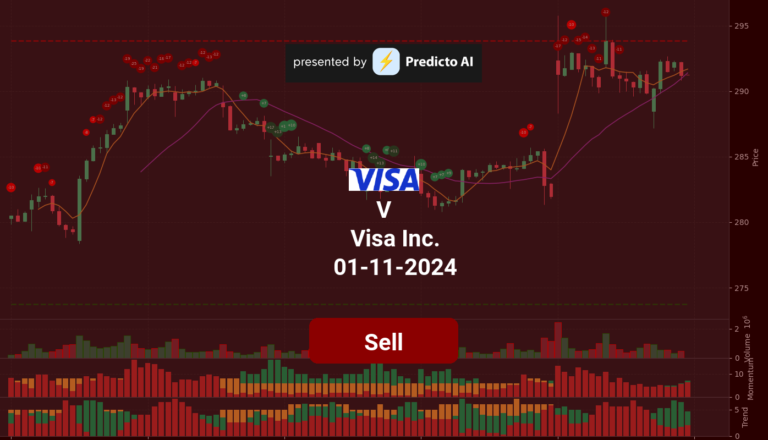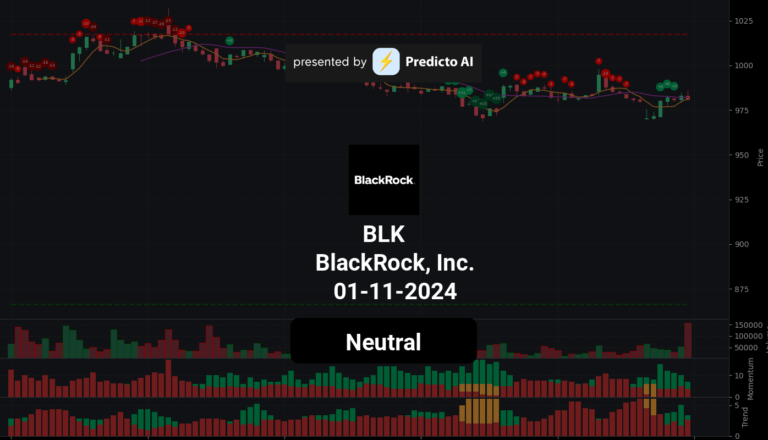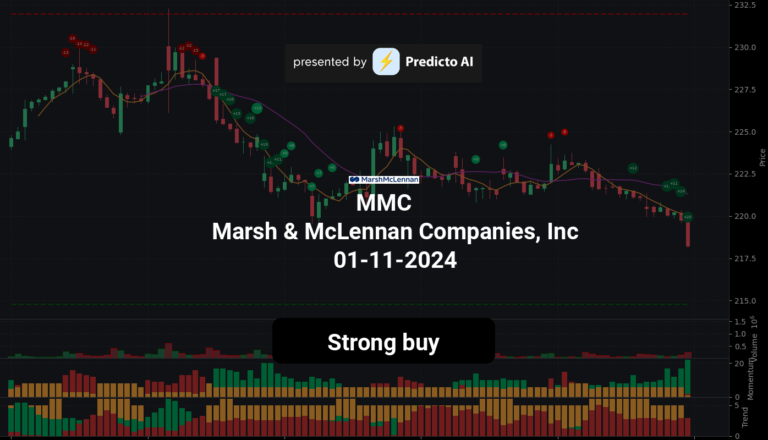RTX Stock Analysis: A Mixed Outlook Ahead!
🔴 Recommendation: RTX is currently presenting a neutral position with a blend of positive and cautionary indicators, suggesting that investors should proceed with care.
📈 Key Highlights:
Technical Indicators: The stock is showing signs of being oversold according to the WaveTrend indicator, coupled with a bullish trend as it trades above both the 50-day and 200-day EMA.
Financial Health: Despite a robust net income of $111 billion, the year-over-year trend reveals a concerning decrease, raising questions about future profitability.
Institutional Support: High institutional ownership at 83.11% indicates strong confidence from large investors, although low insider ownership at 0.08% raises some red flags.
⚠️ Caution Flags:
Profitability Concerns: A significant earnings growth decline of -91.10% and a low net profit margin of 0.56% could hinder future performance.
Valuation Worries: The forward P/E ratio of 20.25 suggests potential overvaluation, especially in light of the bearish sentiment surrounding the stock.
As we delve deeper into the analysis, we will explore the price trends, detailed indicators, financial health, valuation metrics, and more to provide a comprehensive view of RTX’s current standing and future prospects. Stay tuned for an in-depth breakdown! 👇
RTX Price Analysis

| Positive Momentum Signals | Negative Momentum Signals | Hold Momentum Signals |
|---|---|---|
|
|
|
| Positive Trend Signals | Negative Trend Signals | Hold Trend Signals |
|---|---|---|
|
|
|
RTX stock presents a complex picture for investors. Currently, the stock is in a neutral position with some mixed signals from various momentum and trend indicators. On the positive side, the WaveTrend indicator suggests the stock is oversold, indicating a potential bottom and a possible buying opportunity. Additionally, the stock is trading above both the 50-day and 200-day EMA, which signifies a bullish trend that is strengthening. The On-Balance Volume (OBV) is also increasing, supported by high volume, further indicating positive momentum.
However, caution is warranted as the stock is closer to resistance, which could limit upside potential in the short term. The price is currently above the middle band but below the upper band, suggesting that while the stock is in an uptrend, it may be approaching overbought conditions. The Supertrend indicator is bullish, with the price having crossed above it, but the proximity to resistance levels raises concerns about potential pullbacks.
In summary, while RTX shows several positive indicators, including a strong bullish trend and increasing volume, the current resistance levels and the potential for overbought conditions suggest that investors should proceed with caution. A hold strategy may be advisable until clearer signals of sustained upward momentum emerge.
RTX Fundamental Analysis
RTX’s recent financial performance presents a mixed picture, with several concerning indicators overshadowing some positive aspects.
The company’s net income for the most recent period stands at $111 billion; however, the year-over-year trend shows a significant decrease, raising alarms about future profitability. Compounding this issue is the negative net interest income of $469 million, indicating that RTX is paying more in interest than it earns on its assets. Additionally, a low current ratio of 0.57 suggests potential liquidity risks, making it challenging for the company to meet its short-term obligations. The average tangible book value is also troubling, at a negative $-24.86 billion, signaling that liabilities exceed assets, which could deter potential investors.
From a valuation perspective, the forward P/E ratio of 20.25 may imply that the stock is overvalued, especially in light of the alarming negative earnings growth of -91.10%. The price-to-sales ratio of 2.28 further indicates potential overvaluation, particularly given the bearish sentiment surrounding the stock.
In terms of growth and profitability, total revenue for the most recent period was $19.72 billion, reflecting a modest year-over-year growth of 2.15%. However, the net profit margin is low at 0.56%, suggesting difficulties in controlling costs and generating profits. The drastic earnings growth decline of -91.10% raises significant concerns about the company’s ability to maintain profitability moving forward.
Looking at shareholder information, the average treasury shares of 385.81 million may indicate management’s confidence in the company’s future through share buybacks. However, the average ordinary shares outstanding of 1.38 billion could dilute earnings per share if not managed effectively.
The income statement shows a high operating margin of 100.00%, which suggests efficient operations and good cost control. Yet, the concerning net profit margin of 0.56% indicates challenges in converting revenue into profit.
On the balance sheet, the average net debt is high at $34.08 billion, which necessitates further scrutiny regarding its impact on financial flexibility and debt servicing capabilities. The debt-to-equity ratio of -1.66 points to a high level of leverage, posing risks depending on the company’s industry and profitability. Furthermore, a low cash to total assets ratio of 0.04 indicates limited financial flexibility and vulnerability to economic downturns.
In terms of cash flow, average capital expenditures of $2.59 billion suggest that the company is investing in growth and expansion. Positive net cash from financing at $14.97 billion indicates that RTX is raising capital, which could be utilized for growth or debt reduction. However, stock repurchases totaling $4.51 billion, while potentially a positive signal, warrant careful assessment regarding their impact on cash reserves and overall financial flexibility.
Overall, while RTX exhibits some positive indicators, the significant concerns regarding profitability, high debt levels, and liquidity risks lead to a neutral outlook for the stock. Investors should proceed with caution and thoroughly evaluate the company’s ability to navigate its challenges before considering any investment.
Financial Health
🔴 Net Income for the most recent period was $111 billion, but the year-over-year net income trend shows a decrease, raising concerns about future profitability.
🔴 The net interest income is negative at $469 million, indicating that the company is paying more in interest than it earns on its assets.
🔴 The current ratio is low at 0.57, suggesting potential liquidity risk and challenges in meeting short-term obligations.
🔴 The average tangible book value is negative at $-24.86 billion, indicating that liabilities exceed assets, which could be a red flag for investors.
Valuation
🔴 The forward P/E ratio is 20.25, which may suggest the stock is overvalued given the negative earnings growth of -91.10%.
🔴 The price-to-sales ratio of 2.28 indicates potential overvaluation, especially in light of the bearish overall sentiment.
Growth and Profitability
🟢 Total revenue for the most recent period was $19.72 billion, with a year-over-year revenue growth of 2.15%, suggesting moderate growth.
🔴 The net profit margin is low at 0.56%, which could indicate challenges in controlling costs and generating profits.
🔴 The earnings growth of -91.10% raises significant concerns about the company’s future profitability.
Shareholder Information
🟢 The average treasury shares of 385.81 million could indicate management’s confidence in the company’s future through share buybacks.
🔴 The average ordinary shares outstanding is 1.38 billion, which could dilute earnings per share if not managed properly.
Income Statement
🟢 Operating margin is high at 100.00%, suggesting efficient operations and good cost control.
🔴 The net profit margin of 0.56% is concerning, indicating that the company may struggle to convert revenue into profit.
Balance Sheet
🔴 Average net debt is high at $34.08 billion, which warrants further investigation into its impact on financial flexibility and debt servicing.
🔴 The debt-to-equity ratio of -1.66 suggests a high level of leverage, which may pose risks depending on the company’s industry and profitability.
🔴 The cash to total assets ratio is low at 0.04, indicating limited financial flexibility and vulnerability to economic shocks.
Cashflow
🟢 Average capital expenditures of $2.59 billion suggest the company is investing in growth and expansion.
🟢 Positive net cash from financing at $14.97 billion indicates that the company is raising capital, which could be used for growth or debt reduction.
🔴 Stock repurchases of $4.51 billion could be a positive signal, but it is essential to assess the impact on cash reserves and financial flexibility.
Overall, while there are some positive indicators, the concerns regarding profitability, high debt levels, and liquidity risks lead to a neutral outlook for RTX.
RTX News Analysis
RTX News: A favorable outlook for investors.
Summary of RTX news indicates a generally positive sentiment surrounding Raytheon Technologies Corporation (RTX). The company is making significant advancements in defense technology and securing substantial contracts, which could enhance its market position and financial performance. Investors should consider these developments as they reflect the company’s growth potential and resilience in a competitive industry.
🟢 Raytheon Technologies has developed a laser weapon capable of targeting drones at a cost-effective rate of $3 per beam, showcasing innovation in defense technology.
🟢 The intrinsic value of RTX is estimated to be 26% above its current share price, suggesting that the stock may be undervalued and presents a buying opportunity.
🟢 A recent article highlights RTX as a momentum stock, indicating strong performance trends that could attract more investors.
🟢 The company is also benefiting from increased defense spending as global conflicts escalate, which may lead to higher demand for its products.
🟢 RTX has secured a $736 million contract from the US Navy for AIM-9X Sidewinder missiles, further solidifying its position in the defense sector.
🟢 Additionally, RTX’s arm has received a contract to develop ultra-wide bandgap semiconductors, indicating diversification and innovation in technology.
🔴 Despite the positive developments, investors should remain cautious of market volatility and geopolitical risks that could impact defense stocks.
RTX Holders Analysis
The stock of RTX presents a mixed outlook for the next month, driven by strong institutional ownership but tempered by low insider ownership and recent selling activity.
🟢 RTX has a high institutional ownership at **83.11%**, indicating significant interest from large investors, which typically suggests confidence in the company’s future performance. Major holders like Vanguard Group and Blackrock have substantial stakes, reflecting a strong institutional backing.
🔴 However, the **insider ownership is very low at 0.08%**, which may indicate a lack of confidence from company management or a high degree of external control. This could lead to concerns about the alignment of interests between management and shareholders.
🟡 The number of institutional holders is quite large at **2949**, suggesting a diversified ownership base, which can help stabilize the stock price against volatility from individual investors.
🔴 Recent insider transactions show a notable amount of selling, with insiders divesting shares. This could be interpreted as a lack of confidence in the short-term prospects of the company.
🟡 Despite the selling, the overall sentiment from institutional investors remains positive, and the stock has shown resilience in the face of market fluctuations.
In summary, while the strong institutional backing is a positive sign, the low insider ownership and recent selling activity warrant a cautious approach. Therefore, a **Buy** recommendation is appropriate, with the expectation of moderate price movement in the next month, potentially in the range of **$85 to $90** per share, depending on market conditions.
RTX Analyst Ratings
The analyst ratings for RTX show a mixed sentiment, with a notable number of hold and buy recommendations. In the past month, there have been 2 strong buy ratings, 7 buy ratings, 16 hold ratings, 1 sell rating, and 1 strong sell rating. This indicates a cautious outlook among analysts. 🔴 The recent upgrades from Deutsche Bank and B of A Securities suggest some positive momentum, but the overall distribution of ratings leans towards a neutral stance.
🟡 Given the mixed analyst sentiment and the lack of strong buy recommendations, it is likely that RTX will experience moderate performance over the next month. The medium confidence level reflects the uncertainty in the market, with potential fluctuations in stock price. A forecasted price range could be between $85 to $90, depending on market conditions and investor sentiment.
RTX Economic Analysis
Based on the US economic and market data:
🔴 The unemployment rate has increased to 4.3%, up from 4.1% in the previous month, indicating a potential slowdown in the labor market which could negatively impact consumer spending and overall economic growth.
🟡 Retail sales have shown a slight increase to 627,510, but this is not substantial enough to indicate strong consumer demand, especially in the context of rising unemployment.
🟢 The GDP growth remains relatively stable at 5737.189, suggesting that the economy is not in a recession, which is a positive sign for RTX’s long-term outlook.
🔴 The CPI data indicates inflationary pressures, which could lead to tighter monetary policy from the Federal Reserve, potentially impacting defense and aerospace spending.
🟡 The recent changes in Treasury yields and commodity prices are not available, but historically, rising yields can negatively affect stock prices, particularly in capital-intensive sectors like aerospace and defense.
Overall, while RTX has a solid business model and operates in a critical industry, the current economic indicators suggest a cautious approach. The increase in unemployment and moderate retail sales could hinder growth in the near term.
Disclaimer
Investors may consider the AI predictions and news summaries as one factor in their investment decisions alongside their own research and risk tolerance.




